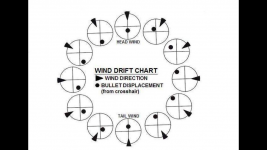By Ted Hoeger “@Jack Master”
Gone are the days of doing long mental math on the shooting line or in the field. Ballistic calculators have advanced shooting to a new level that make things easy on the brain. The only downfall to a ballistic computer is being able to adjust to changing wind direction and speed quickly. As a shooter, the ability to read the wind and make quick adjustments will increase our hit percentages. Using a ballistic computer to look up two wind values from 2 directions can be long and tedious. If you have the time and opportunity, a ballistic computer is usually your best solution, but what about when you don’t have a ballistic computer, are in a place electronics don’t work or need a faster method? We are shooting further at smaller targets than ever, so having a solid starting wind call is a must.
A Quick Wind Lesson
When making wind calls, we need to know the crosswind speed. We need to know how much of the wind blowing at an angle to...
Continue reading...
Last edited:


